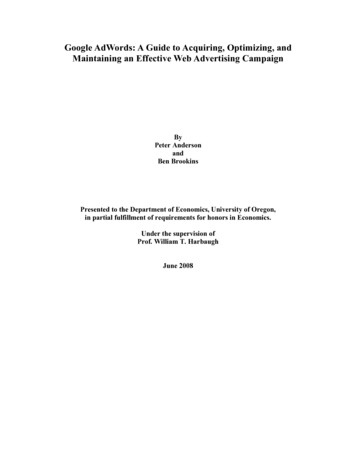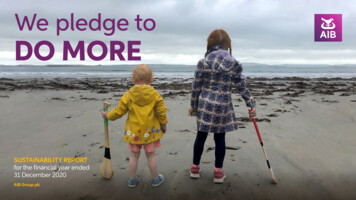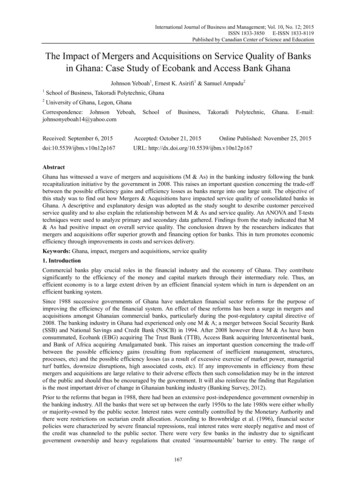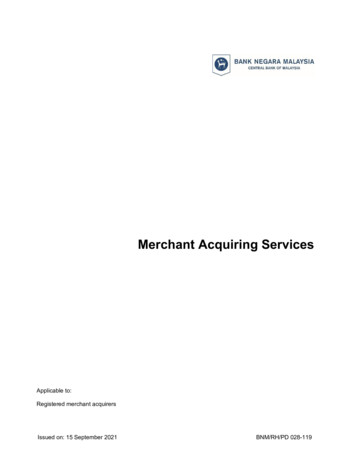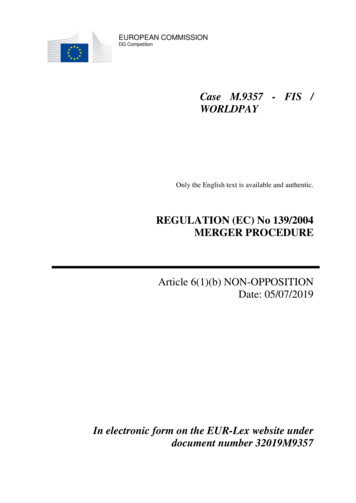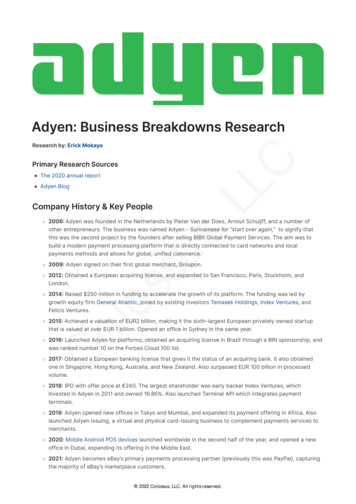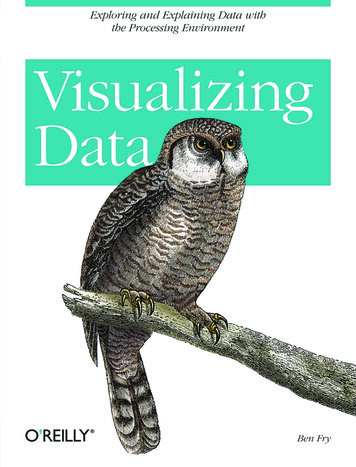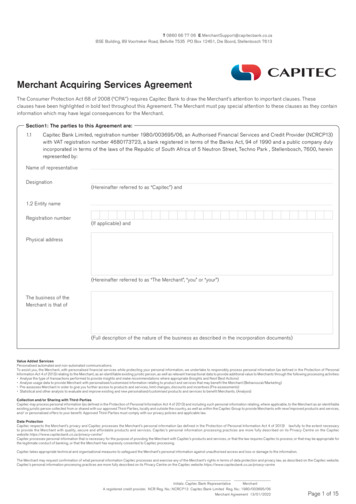
Transcription
SAFE AND SECURE: GUIDES TO CREATING SAFER SCHOOLSAcquiring and Utilizing ResourcesGUIDE 8 To Enhance and Sustain aSafe Learning EnvironmentNORTHWEST REGIONALEDUCATIONAL LABORATORYSAFE AND DRUG-FREESCHOOLS PROGRAMU.S. DEPARTMENT OFEDUCATIONOFFICE OF JUVENILEJUSTICE AND DELINQUENCYPREVENTIONU.S. DEPARTMENT OF JUSTICE
SAFE AND SECURE: GUIDES TO CREATING SAFER SCHOOLSAcquiring and Utilizing ResourcesGUIDE 8 To Enhance and Sustain aSafe Learning EnvironmentBy Mary Grenz Jalloh, M.S., M.P.H., C.H.E.S., and Kathleen Schmalz, R.N., Ed.D., C.H.E.S.September 2002NORTHWEST REGIONALEDUCATIONAL LABORATORY
NORTHWEST REGIONAL EDUCATIONAL LABORATORYiCONTENTSForeword . . . . . . . . . . . . . . . . . . . . . . . . . . . . . . . . . . . . . . . . . . . . . . . . . . . . . . . . . . . . . . . . . . . . . . . . . . . . . . . . . . . . . . . . . .iiiIntroduction . . . . . . . . . . . . . . . . . . . . . . . . . . . . . . . . . . . . . . . . . . . . . . . . . . . . . . . . . . . . . . . . . . . . . . . . . . . . . . . . . . . . . . . .1What Are Resources? . . . . . . . . . . . . . . . . . . . . . . . . . . . . . . . . . . . . . . . . . . . . . . . . . . . . . . . . . . . . . . . . . . . . . . . . . . . . . . . .3What Role Do Resources Play in Safe School Planning? . . . . . . . . . . . . . . . . . . . . . . . . . . . . . . . . . . . . . . . . . . . . . . . . .5Identifying and Accessing Resources . . . . . . . . . . . . . . . . . . . . . . . . . . . . . . . . . . . . . . . . . . . . . . . . . . . . . . . . . . . . . . . .19Conclusion . . . . . . . . . . . . . . . . . . . . . . . . . . . . . . . . . . . . . . . . . . . . . . . . . . . . . . . . . . . . . . . . . . . . . . . . . . . . . . . . . . . . . . . .23References . . . . . . . . . . . . . . . . . . . . . . . . . . . . . . . . . . . . . . . . . . . . . . . . . . . . . . . . . . . . . . . . . . . . . . . . . . . . . . . . . . . . . . . .25Resources . . . . . . . . . . . . . . . . . . . . . . . . . . . . . . . . . . . . . . . . . . . . . . . . . . . . . . . . . . . . . . . . . . . . . . . . . . . . . . . . . . . . . . . .27
NORTHWEST REGIONAL EDUCATIONAL LABORATORYiiiFOREWORDSchool safety requires a broad-based effort by the entire community, including educators, students, parents,law enforcement agencies, businesses, and faith-based organizations, among others. By adopting a comprehensive approach to addressing school safety focusing on prevention, intervention, and response, schoolscan increase the safety and security of students.To assist schools in their safety efforts, the Northwest Regional Educational Laboratory (NWREL) hasdeveloped a series of eight guidebooks intended to build a foundation of information that will assist schoolsand school districts in developing safe learning environments. NWREL has identified several componentsthat, when effectively addressed, provide schools with the foundation and building blocks needed to ensurea safe learning environment. These technical assistance guides, written in collaboration with leading nationalexperts, will provide local school districts with information and resources that support comprehensive safeschool planning efforts.One objective of the guides is to foster a sense of community and connection among schools and thoseorganizations and agencies that work together to enhance and sustain safe learning environments. Anotherobjective is to increase awareness of current themes and concerns in the area of safe schools.Each guide provides administrators and classroom practitioners with a glimpse of how fellow educatorsare addressing issues, overcoming obstacles, and attaining success in key areas of school safety. Theseguidebooks will assist educators in obtaining current, reliable, and useful information on topics that shouldbe considered as they develop safe school strategies and positive learning environments.Each of the guidebooks should be viewed as one component of a school’s overall effort to create a saferlearning environment. As emphasized in Threat Assessment in Schools: A Guide to Managing Threatening Situations and to Creating Safe School Climates, a joint publication of the U.S. Secret Service and the U.S. Department of Education, creating cultures and climates of safety is essential to the prevention of violence in school.Each guidebook contains this message as a fundamental concept.Under No Child Left Behind, the education law signed in January 2002, violence prevention programs mustmeet specified principles of effectiveness and be grounded in scientifically based research that providesevidence that the program to be used will reduce violence and illegal drug use. Building on the concept inNo Child Left Behind—that all children need a safe environment in which to learn and achieve—these guidesexplain the importance of selecting research-based programs and strategies. The guides also outline a sampleof methods on how to address and solve issues schools may encounter in their efforts to create and enhancesafe learning environments.Guide 1: Creating Schoolwide Prevention and Intervention Strategies, by Jeffrey Sprague and HillWalker, is intended to put the issue of schoolwide violence prevention in context for educators and outlinean approach for choosing and creating effective prevention programs. The guide covers the following topics: Why schoolwide prevention strategies are critical Characteristics of a safe school Four sources of vulnerability to school violence How to plan for strategies that meet school safety needs Five effective response strategies Useful Web and print resourcesGuide 2: School Policies and Legal Issues Supporting Safe Schools, by Kirk Bailey, is a practicalguide to the development and implementation of school policies that support safe schools. Section 1 providesan overview of guiding principles to keep in mind when developing policies at the district level to prevent violence. Section 2 addresses specific policy and legal components that relate to such topics as discipline anddue process, threats of violence, suspension and expulsion, zero tolerance, and dress codes. Checklists areincluded to ensure that schools attend to due process when developing policies for suspensions or expulsions,search and seizure, or general liability issues.
ivAcquiring and Utilizing Resources To Enhance and Sustain a Safe Learning EnvironmentGuide 3: Implementing Ongoing Staff Development To Enhance Safe Schools, by Steve Kimberlingand Cyril Wantland, discusses the role of staff development within the context of school safety. The guideaddresses how staff development should be an integral part of the educational planning process and discusses what its relationship is to safety-related outcomes and overall student achievement.Guide 4: Ensuring Quality School Facilities and Security Technologies, by Tod Schneider, is intendedto help educators and other members of the community understand the relationship between school safetyand school facilities, including technology. The guide covers the following topics: Crime Prevention Through Environmental Design (CPTED) Planning To Address CPTED: Key Questions To Ask Security Technology: An Overview Safety Audits and Security SurveysGuide 5: Fostering School-Law Enforcement Partnerships, by Anne Atkinson is a practical guide to thedevelopment and implementation of partnerships between schools and law enforcement agencies. Section 1provides an overview of community policing and its relationship to school effectiveness. Section 2 focuses ondeveloping the school-law enforcement partnership from an interagency perspective. Section 3 focuses onsteps for implementing school–law enforcement partnerships in schools. Also included are descriptions ofthe roles of law enforcement in schools with examples of many strategies used to make schools safer andmore effective.Guide 6: Instituting School-Based Links With Mental Health and Social Service Agencies, byDavid Osher and Sandra Keenan, discusses how schools can improve their capacity to serve all students bylinking with mental health and social service agencies. Agency staff members can contribute to individual andschoolwide assessment, planning, implementation, and evaluation. Agency resources can enhance schools’capacity to provide universal, early, and intensive interventions. Links with agency resources can also alignschool and agency services.Guide 7: Fostering School, Family, and Community Involvement, by Howard Adelman and LindaTaylor, provides an overview of the nature and scope of collaboration, explores barriers to effectively workingtogether, and discusses the processes of establishing and sustaining the work. It also reviews the state of theart of collaboration around the country, the importance of data, and some issues related to sharing information.Guide 8: Acquiring and Utilizing Resources To Enhance and Sustain a Safe Learning Environment, by Mary Grenz Jalloh and Kathleen Schmalz, provides practical information on a spectrum of resourcesthat concerned individuals and organizations can use in the quest to create safe schools. It draws on published research and also includes interviews with experts working on school safety issues at the state andlocal levels. Major topics covered include: What are resources? What role do resources play in safe school planning? Identifying and accessing resources Appendix of online and print resources—Northwest Regional Educational Laboratory
NORTHWEST REGIONAL EDUCATIONAL LABORATORY1INTRODUCTIONI understand why kids kill . Other kids hit them, tease them, bully them all the time. I would want to hurtthem, too.—12-year-old boy responding to publicized school shooting(Newman, Horne, & Bartolomucci, 2000, p. 24)Amid such headline-making events as the Columbine High School shooting, many people may be surprisedto learn that schools remain the safest places for children to be. Most schools are doing an admirable job ofkeeping the premises safe for students and staff. In fact, the proportion of students reporting fears of attackor gang violence at school declined noticeably between 1995 and 1999 (Small & Tetrick, 2001). However, aslong as even a few children dread going to school, whether the cause is a high-profile bloodbath or a tauntfrom a bullying classmate, there is a need for well-planned, multifaceted school violence prevention programs.Recent events have led many states to institute laws requiring schools to put measures in place to protectstudents and staff. By 2002, 18 states had chosen to provide resources to their schools by establishing orextending state school safety centers. In some states, these have emerged as parts of a state agency. In others,they exist as a collaboratively funded entity with ties to local educational units or state university systems.While the structure of school safety centers varies state to state, most work to provide technical assistance,training, and clearinghouse resources to constituent school districts in their state. In addition, they serve asresource centers for state agencies, community and professional organizations, and policymakers within eachof their states.New York has extended the work of its school safety center (New York State Center for School Safety[NYSCSS]) to provide support to schools enacting what has been termed the “most comprehensive” pieceof school safety legislation in the nation. While this guide is intended for audiences all across the country, itis informed by the experiences of safe school planning in New York.On July 24, 2000, the Safe Schools Against Violence in Education Act (SAVE) was enacted in New York State(Project SAVE, 2001). Project SAVE concluded the work of the Task Force on School Violence chaired by Lieutenant Governor Mary O. Donohue, and represented the collaborative efforts of law enforcement experts,business leaders, mental health professionals, and elected officials—an example of the human resourcesinvolved in the massive initiative to make all schools safe.The final report by the task force, Safer Schools for the 21st Century, included a set of recommendationsfor reducing violence in the school and reinforcing the ability of schools to respond to emergencies that couldendanger the welfare of students (Project SAVE, 2001). A central theme in the task force meetings was thecrucial importance of ongoing dialogue among stakeholders to leverage all available resources toward creatingthe safe, supportive school environment that is intrinsically linked with academic achievement. Children learnbest in a safe environment where they feel their rights, and those of others, are respected. Strategic andinnovative use of resources is key to creating safe and supportive learning communities.What This Guide IncludesThis guidebook provides practical information on a spectrum of resources that concerned individuals andorganizations can use in the quest to create safe schools. It draws on published research and also includesinterviews with experts working on school safety issues at the state and local levels.Major topics covered include: What are resources? What role do resources play in safe school planning? Identifying and accessing resources Appendix of online and print resources
2Acquiring and Utilizing Resources To Enhance and Sustain a Safe Learning EnvironmentIn the design of comprehensive school violence prevention programs, a perennial obstacle has been the lackof a clear-cut definition of violence. The Respect and Protect program developed an operational definitionencompassing both physical and nonphysical violence. While this is by no means a universally accepteddefinition of violence, it offers a framework for the discussion in this guide:Violence occurs whenever anyone inflicts or threatens to inflict physical or emotional injury ordiscomfort upon another person’s body, feelings, or possessions.—Remboldt (1994, p. 5)Simplified for children and adolescents:Violence is any mean word, look, sign, or act that hurts a person’s body, feelings, or things.—Remboldt (1994, p. 6)Defining what we mean by resources may seem just as challenging. That, and other pertinent questions, willbe addressed in the following sections.
NORTHWEST REGIONAL EDUCATIONAL LABORATORY3WHAT ARE RESOURCES?From traditional organizations such as Parent Teacher Associations (PTA) to the growing number of relatedWeb sites, a wealth of individuals, agencies, organizations, materials, strategies, and techniques can bedeployed to strengthen school violence prevention efforts.Human ResourcesSeveral components of safe school planning refer to the most important type of resources for creating safeschools: human resources. Collaborative partnerships with law enforcement, mental health and human servicesprofessionals, parents, and community members are vital to the success of a school violence prevention plan.Within the school, teachers and support staff are essential human resources; thus, staff development is animportant part of a comprehensive plan. Most important of all are the students: Involving students gives thema sense of ownership in the plan and the school and instills in them a sense of responsibility. Students whomodel positive social behavior and are willing to intervene on behalf of their peers (or, especially, youngerchildren) are crucial to the success of a program designed to convey the message that it’s cool to settleconflict peacefully and to show others that everyone counts.The importance of human resources was identified by the U.S. Department of Education as one of the fundamental qualities of a safe and responsible school: strong leadership, caring faculty, family and communityinvolvement from all sectors, and student involvement (National Criminal Justice Reference Service, 2002).The importance of involving all stakeholders was emphasized for both program design and policy development.When involving stakeholders in the process of planning for school safety, the U.S. Department of Educationalso identifies the critical need for supportive staff development, so that all participants are given the skillsand support necessary to design and implement program strategies.InformationInformation is a second type of resource, although a constant bombardment of information carries the danger that much of it may be distorted, or even blatantly false. The media coverage of high-profile cases ofschool violence tends to convey the impression that knives and guns in schools are as common, and carriedas nonchalantly, as cell phones and sneakers. Even researchers admit that data on youth violence are oftenmisinterpreted or misunderstood, when people attempt to find simple solutions to complex problems. Certain identified factors may predispose youth toward violence, but predisposed does not mean predetermined.Identifiable factors are associated with choices to engage in either violent or nonviolent behavior. Havingaccurate information on the complex interaction of factors and the way youth make behavioral choices is aprerequisite for designing effective programs (New York State Center for School Safety [NYSCSS], 2001).Information is a major element of any effective prevention program. Research on drug-abuse preventionhas determined that children and adolescents respond better to concrete information and “here-and-now”experiences than to more remote possibilities like long-term consequences. Information targeting childrenand youth should be accurate and personally relevant and focused on immediate or short-term consequences(Upstate Center for School Safety, 2000).For adults, public information and education campaigns can work to enlist community members in violence prevention while dispelling popular myths and misconceptions (perhaps the #1 myth is, “It can’t happenhere”). Accurate information can be viewed as the first line of defense and the first line of intervention.School safety teams need to access information in their planning process to identify the needs they areaddressing and determine interventions based on this assessment. This fits with the U.S. Department ofEducation’s Principles of Effectiveness, which were developed to guide states and districts in a strategicplanning process for safe and drug-free schools (see Page 11 for more information on the Principles ofEffectiveness.)
4Acquiring and Utilizing Resources To Enhance and Sustain a Safe Learning EnvironmentOnline information resources range from general Web sites such as the American Association of SchoolAdministrators (www.aasa.org) to the New York State Center for School Safety (www.mhric.org/scss), to morespecific Web sites such as Facts About Gun Violence (www.abanet.org/gunviol/schoolshm.html) sponsored bythe American Bar Association, or the American Psychological Association’s (APA) Is Youth Violence Just AnotherFact of Life? (www.apa.org/pi/pii/isyouthviolence.html), which dispels many prevalent myths. The APA clearlystates that violence is a learned behavior, not a genetic trait. By identifying the ways in which children learnviolence, the APA offers valuable information on how program developers can help children replace the lessonsof violence with lessons that stress the benefits of positive behavior. (See Resources.)These are only a few of the online resources addressing school violence and safety. Federal, state, and localagencies all publish documents that can be used in the design of a comprehensive school safety program.Although legislation and focus differ with state and locality, identified best practices can readily be adaptedto comply with local laws or suit the needs of a particular community.TimeTime constraints are routinely cited as a reason for the absence or shortage of staff development programsin schools or the failure of a promising program. While there may be far less time than information, bothneed to be targeted to be fully effective program components. Expanding human resources may entail juggling schedules or holding meetings at unusual times, such as Friday or Sunday evenings. Most parents workoutside the home, with limited flexibility with regard to taking time off to volunteer as members of schoolsafety planning teams. Children in all communities may live with caregivers other than parents. It is essentialto recognize them as respected adults and as the child’s first-line source of support. Parents and local community members are most likely to be involved in a program that treats them as valued contributors by takingtheir needs into consideration.Strategically planning time goals and allotting the time needed for each facet of the program to be carriedout can make a crucial difference between program success and failure. Setting realistic time goals is a keyfactor in planning any endeavor.Strategies for Resource UtilizationIn the “Guidelines for Developing School Safety Plans,” the school safety work group of Project SAVE includeda list of suggestions that can be used to guide effective use of resources. The work group cautions againstthe two contrasting impediments to efficient organization: redundancy and cutting corners. To avoid thesepitfalls: Build upon strengths: Schools should build upon existing plans and activities, as well as the ideasand experience of others who have successfully designed and implemented school safety plans. Remember that leadership is important: School and community leadership is essential atall stages of the planning process. Good leadership works to build and maintain the momentum forsuccessful planning. Be aware that successful planning takes time: Be sure that the planning process allows sufficienttime for broad participation and active involvement by key stakeholders in the development of plans. Avoid “packaged products”: Using a packaged or “off the shelf” school safety plan may seem like atempting option, but it may be a poor solution to addressing your school’s or district’s specific needs. Consider formal arrangements if needed: Personnel changes, organizational restructuring, orother factors within the schools and/or collaborating agencies may require formal agreements, as wellas periodic review and updates to ensure the durability of plans over time(Project SAVE, 2001, p. 11).Now that the concept of resources has been defined, the next step in the planning process is determininghow resources are best used in planning for safer schools.
NORTHWEST REGIONAL EDUCATIONAL LABORATORY5WHAT ROLE DO RESOURCES PLAY IN SAFE SCHOOL PLANNING?To effectively synthesize the essential components of safe school planning, the Northwest Regional EducationalLaboratory recommends that schools follow a strategic plan consisting of six steps: Building school–community partnerships Conducting comprehensive needs assessment Developing a comprehensive school plan Identifying strategies and implementing programs Conducting an evaluation Sharing outcomes and making adjustments(Pollack & Sundermann, 2001, p. 15)The following section delineates the role that resources play in each step of the strategic process.1. Building School–Community PartnershipsParent and community involvement is a key factor in creating a safe school climate. Constituents includestudents, parents, teachers, school administrators, support staff, local business and civic leaders, and lawenforcement officials. Each group brings unique strengths to the process of planning for safer schools,although there are challenges in effectively synthesizing the perspectives of disparate groups.Developers have a number of models to draw upon, including both programs created specifically to addressschool violence and safety, as well as comprehensive school models that recognize the importance of includingparents and community members in other aspects of planning and program design. There are many examplesof innovative programs devised by schools to create a safe and supportive learning environment. The followingare examples of school–community partnerships developed through Safe Schools/ Healthy Students grants(Pollack & Sundermann, 2001, pp. 15–16): In Denver, Colorado, public schools have established ongoing communication between the school districtand the Denver Police Department. In addition to hiring school safety officers, the schools have institutedcommunity–school assistance teams and hired “quadrant liaisons” to provide training and technicalassistance to schools, families, community members, and the staff of collaborating agencies to addressthe mental health and social behavior needs of students and families. The initiative is coordinated by acouncil representing the stakeholder groups involved in the project. In Polk County, Iowa, 100 citizens representing more than 50 organizations joined to devise a plan toenhance the quality of life of local youth. The dual goals of the program are the creation of a comprehensive drug and violence prevention curriculum (targeting alcohol and tobacco use as well as illicitdrug use) and the promotion of extensive parent involvement. School-based intensive case managementservices provide parents and families with comprehensive mental health and social services, a schooltransitioning program, and Parents as Teachers programming, as well as targeted drug and violenceprevention efforts.
6Acquiring and Utilizing Resources To Enhance and Sustain a Safe Learning Environment The Comer School Development Program has a proven track record for turning around the learning conditions of troubled inner-city schools. The Parent Program of the Comer schools has been singled out asan exemplary way to create a safe learning environment (Peterson & Skiba, 2001). The Parent Programsolicits the active participation of parents as members of the School Development Committee, one ofthree core school governance bodies, as well as in the more traditional roles of classroom aides andvolunteers in social activities. The success of the program derives from the fact that from the onset ofplanning, parents are treated as equal and valued partners. Many Comer schools have site-specificparent-led violence prevention initiatives.The No Child Left Behind Act of 2002, under Title IV, authorizes additional appropriations for the 21st CenturyCommunity Learning Center Initiative. The legislation contains several provisions that address the importanceof collaboratives. The Non-Regulatory Draft Guidance describes the advantage of collaboration:By bringing together community organizations with school districts, centers can take advantageof multiple resources in the community. Community learning centers can offer residents in thecommunity an opportunity to volunteer their time and their expertise to help students achieveacademic standards and master new skills. Collaboration can also ensure that the childrenattending a learning center benefit from the collective resources and expertise throughout thecommunity.—U.S. Department of Education (2002, p. 18)Community learning centers represent an excellent way of consolidating resources to create a safe and caring learning environment. Reliance on federal funding represents a top-down approach to organizing community schools. A bottom-up or grassroots approach begins by seeking out local residents who can share theirideas, experience, and knowledge to advance the goal of creating safe schools.Forming effective school–community partnerships does not require major restructuring at the schoollevel. If there is a cultural, social, or ethnic barrier between the community and the school staff, it may bewise to seek out an adviser from the community. In the planning process, listen to what your adviser has tosay about the needs of parents and community members. Do the students have adequate opportunities forengaging in constructive activities after school? Find out what the kids have to say. Once you begin a concertedeffort to engage parents, community leaders, and local residents, you may be surprised at the talents andexpertise you find.The vast majority of parents are interested in their children’s education and their safety at school. Theproblem is that, especially where there is social distance between the school and the community, parentsmay believe teachers and school leaders are not interested in what they have to say. As a result, parents shyaway from involvement. In many schools, parents only hear from the school when their kids are failing or arealready involved in drugs or violence. Involving school families in all stages of planning not only reduces thechances that parents will be defensive when they hear from the school, but also the chance that students willbe involved in an offense to begin with. In general, parent involvement in schools has been linked with higherattendance, fewer suspensions, and higher academic outcomes for students (Peterson & Skiba, 2001).In New York state, legislation has defined the requirement for school–community partnerships throughthe establishment of formal planning teams (Project SAVE, 2001). The guidelines set by the state ensure thatthe teams represent the perspectives of all stakeholder groups, and can be used as a guide for establishingteams to pursue a range of related goals. The state has designated two types of school safety planning teams: The districtwide school safety team: Appointed by the board of education or the chancellor inNew York City, the team must include representatives from the school board; student, teacher, administrator, and parent organizations; school safety personnel; and other school staff members. This representsonly those stakeholders who are required to be on the team. Membership is not limited to these groups.
NORTHWEST REGIONAL EDUCATIONAL LABORATORY7 The building-level school safety team: Appointed by the school principal, the team includes representatives of teacher, administrator, and parent organizations; school safety staff; other school personnel; community members; local law e
linking with mental health and social service agencies. Agency staff members can contribute to individual and schoolwide assessment, planning, implementation, and evaluation. Agency resources can enhance schools' capacity to provide universal, early, and intensive interventions. Links with agency resources can also align school and agency .

